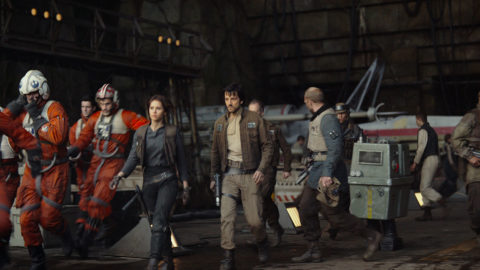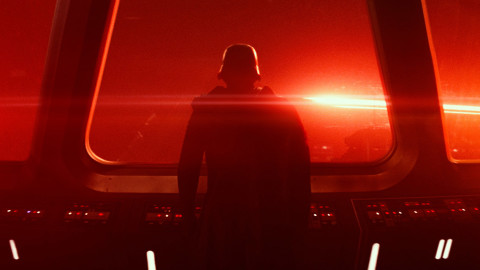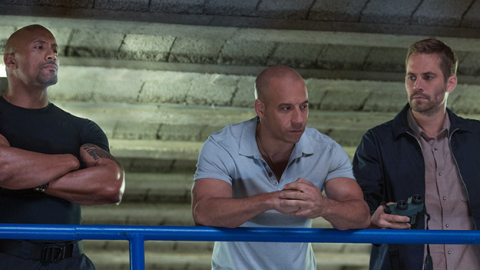Deep Focus: Star Wars: The Last Jedi
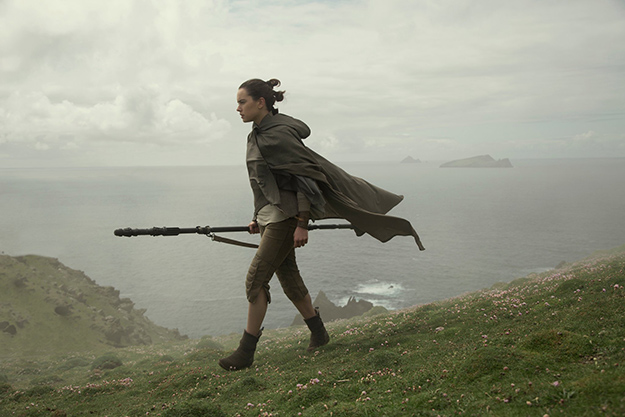
In Rian Johnson’s Star Wars: The Last Jedi, Jedi wannabe Rey (Daisy Ridley) strives to compel Jedi hermit Luke Skywalker (Mark Hamill) to teach her about the Force. Meanwhile, the fascist First Order, spearheaded by Darth Vader manqué Kylo Ren (Adam Driver), struggles to quash the Resistance, led by Luke’s twin, General Leia Organa (Carrie Fisher). By the end, whether the Resistance can restore moral balance to the universe remains in doubt—but there’s no question that writer-director Johnson brings a surprising new equilibrium to the Star Wars franchise. The Last Jedi is refreshingly youthful yet also stirringly mature. Johnson has infused what could have been just another retread with elastic humor, visual luster and vitality, and a slow-burning passion. (At times it burns a tad too slow: two-thirds through its jam-packed 152 minutes, I felt the need for a 7th-inning stretch.)
Despite a jury-rigged subplot about disabling a First Order tracking program that can follow Resistance vehicles through hyperspace, nearly every bout of action takes us closer to the brink of exciting revelations about the Force and its believers. The movie goes all-out with a potent array of cat-and-mouse chases (some in space, some inside spaceships), a thrilling samurai-inspired fight in the deep-crimson throne room of Supreme Leader Snoke (Andy Serkis), and an eye-popping jaunt through the casino and prison of an ultra-decadent gambling planet known as Canto Bight. As the movie careens from one splashy set piece to the next, its most unlikely feat is that it amplifies our connection to pop icons Luke and Leia and a slew of more recent acquaintances.
These include X-wing fighter jock Poe Dameron (Oscar Isaac), here a cocky, take-charge warrior learning how to lead, and former Storm Trooper Finn (John Boyega), an innately righteous man with no traditions to fall back on—he stumbles and improvises his way into valor. One freshly minted hero, a mechanic named Rose Tico (Kelly Marie Tran), blows into the movie with a fan’s enthusiasm, a can-do spirit, and bracing undercurrents of proletarian rebellion. As bold and idealistic as she is practical, she may be the most rousing figure in the bunch. She starts out revering Resistance heroes, then turns into one herself by doing what comes naturally. With chugging energy and sudden freshets of emotion, Tran (an American of Vietnamese heritage) delivers a carpe diem performance.
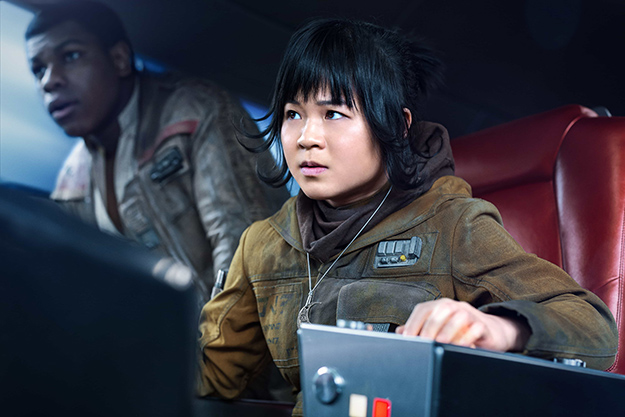
Space-waif Rey, as played by Ridley, already swept us into her cosmic identity crisis in J.J. Abrams’s hit-or-miss pastiche, Star Wars: The Force Awakens (2015). Rey’s quest to discover her lineage and the secrets of her powers niftily re-set the Star Wars canon both for novices and longtime followers. Johnson doesn’t fray the bond Ridley forged with the audience. Her storyline begins where it left off, as Rey confronts Luke on his starkly beautiful island. Bearded, sunken-eyed, and weathered, heftier and more muscular than in his youth, Hamill has become a magnificent camera subject. Always an underrated actor, he wears Luke’s legend lightly as he matches Ridley’s fierceness and commitment, body and soul. Just as Rey’s internal confusions pour through the urgent expressions on Ridley’s open face, Hamill’s grizzled looks and scowling mien convey a self-immolating intensity. On her own, Ridley is such a consummate actor that she makes Rey’s moments of impotence and despair as dynamic as her violent outbursts. At one psychological low point that’s also a cinematic apex, she and Johnson rejuvenate a tired hall-of-mirrors concept. Rey’s gestures get mimicked in multiple and successive reflections, so that a snap of her fingers ricochets for seconds down the corridors of our minds.
What’s daring about The Last Jedi is that Luke now regards Jedi traditions as mere vanities. In his weary, bitter view, the Jedi mystique causes people to think that the Force is a set of superpowers that only Jedi can channel, instead of being an unseen energy that connects all organic matter. Luke’s anger and resentment stem from his guilt over failing Kylo Ren as a teacher, when Kylo was just a stripling called Ben Solo, Han and Leia’s son. Driver’s Kylo moves like a dark cloud over those who once valued or loved him, or anyone who considers him redeemable—like Rey. The Force joins Kylo and Rey repeatedly in abrupt psychic connections, sometimes prodding them to test their powers and very identities against each other. In a movie filled with extravagant action sequences set in breathtaking locales, Johnson generates maximum tension from the mental and spiritual tugs of war between Driver’s moody Kylo and Ridley’s steadfast Rey, who is broadminded to a fault. In these scenes, concepts like a “rupture” or “imbalance” in the Force grow viscerally real.
All good movies have their own version of the Force. We critics call it “directorial vision.” Johnson had it in his first film, Brick (2005), and it has come back here as strong as ever. It isn’t a matter of pulling off camera moves that reveal an auteur’s soul or establish a creative signature. It’s about a writer-director juggling every element of story and production so they drop into place. In an unexpectedly moving moment during the first pitched space battle, a pilot plummets into her bomb bay to see what’s stalling her payload. Johnson salutes her daring and self-sacrifice with a heartbreaking close-up. We can’t tell why we’re touched so deeply by a woman we haven’t had the chance to get to know. But the performance and the structure of the scene, as well as the shooting and editing, provoke a soulful response, and when the payoff arrives, it’s immense. She turns out to be somebody’s sibling in a movie that both celebrates and excoriates relations in every category, including sons and mothers, blood brothers and real sisters.
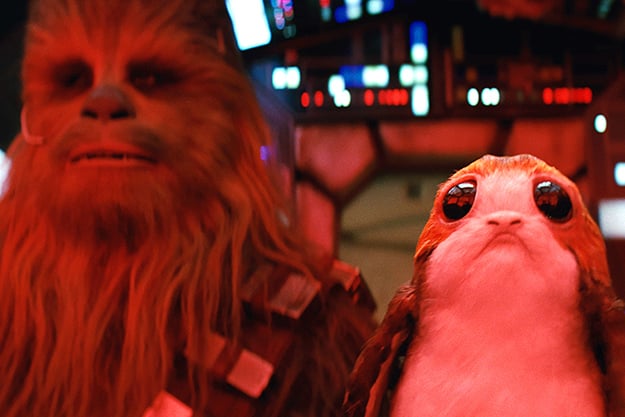
In the world of publicity clichés, every new Star Wars director has been a fan since childhood and had fun each day on the set. I’m sure that’s true of Rian Johnson, but he tempers his affection with an ironic awareness of the franchise. He puts air quotes around the cuteness of the cuddly creatures known as porgs. He knows that adorable creatures are an essential part of the Star Wars marketing blitz, but he often treats them just as cruelly as Joe Dante did his Gremlins. On the other hand, the animals known as “farthiers”—huge horse/camel hybrids with faces like thin lambs—are pure action poetry. And the crystal foxes that roam a planet covered in salt might have loped out of a fever dream.
During the climactic battle on the salt flats, the Resistance pilots fly “surface skimmers” that scrape the salt off and reveal red minerals underneath. It’s a marvelous effect; it’s as if the planet is bleeding. (Not all Johnson’s inspirations are science fiction. Poe’s command, “If they move, stun ’em!” must be an homage to Pike Bishop’s order in The Wild Bunch, “If they move… kill ’em!”)
Star Wars: The Last Jedi may not be perfect, but the need to accept imperfection and keep going becomes one of the movie’s themes. The movie is about viewing failures like Luke’s with Kylo as part of an honest education. It’s about mentorship that’s invigorating rather than smothering.
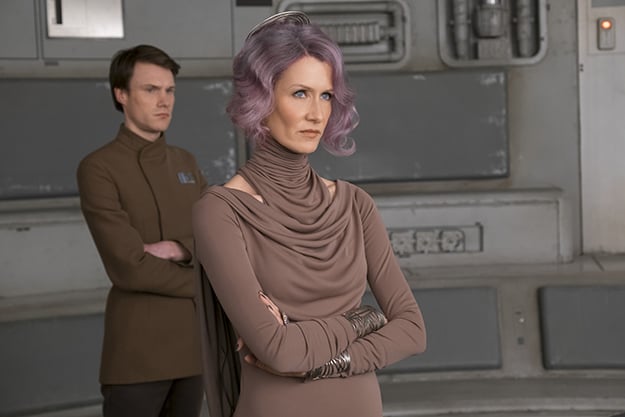
It’s also about knowing when it’s time to leave the stage—and how to make that exit. Fisher’s elder statesman turn as Leia, complete with cane, is poignant partly because her acting is so economical. Her swift efficiency can be funny, as when she stuns Poe right after he greets her, or inspirational, as when she brusquely indicates that the same fighter is ready for promotion. Fisher’s posthumous appearance here soars as high as Harry Dean Stanton’s did in Lucky. This movie has become a fitting swansong for a rara avis.
Michael Sragow is a contributing editor to Film Comment and writes its Deep Focus column. He is a member of the National Society of Film Critics and the Los Angeles Film Critics Association, and a programmer at the Criterion Collection.



